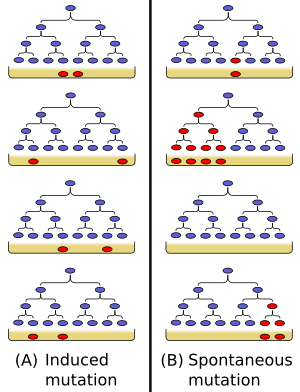Luria–Delbrück experiment facts for kids

The Luria–Delbrück experiment, also known as the 'Fluctuation Test', was done in 1943. It helped answer a big question in biology: Do mutations happen by chance, or do they happen because an organism needs them to survive?
Max Delbrück and Salvador Luria showed that in tiny living things called bacteria, changes in their DNA (called mutations) happen completely by random chance. This means mutations can happen at any time, not just when the bacteria are facing a challenge.
This experiment supported Darwin's idea of natural selection. It showed that natural selection works on random mutations in bacteria, just like it does in bigger, more complex animals and plants.
Delbrück and Luria later won the 1969 Nobel Prize in Physiology or Medicine partly because of this important work.
How the Experiment Worked
In their experiment, Luria and Delbrück grew many groups of bacteria in separate test tubes. After the bacteria had grown for a while, they took an equal amount from each tube. They then spread these bacteria onto special plates that contained a bacteriophage (a type of virus) that could kill the bacteria.
If bacteria only got resistant to the virus when they were on the plate (meaning the virus caused the mutation), then each plate should have had about the same number of surviving bacteria. This is because the chance of a mutation happening would be similar on each plate.
However, this is not what Delbrück and Luria found. Instead, the number of surviving bacteria on each plate was very different. Some plates had many resistant bacteria, while others had very few or none.
Luria and Delbrück explained these results by saying that mutations happen randomly while the bacteria are growing in the test tubes, even before they meet the virus. If a mutation for resistance happened early in a tube's growth, then many resistant bacteria would be present when they were spread onto the plate. If the mutation happened late, or not at all, then fewer resistant bacteria would be on the plate. This "fluctuation" in numbers showed that mutations are random, not caused by the environment.
See also

- In Spanish: Experimento de Luria y Delbrück para niños

